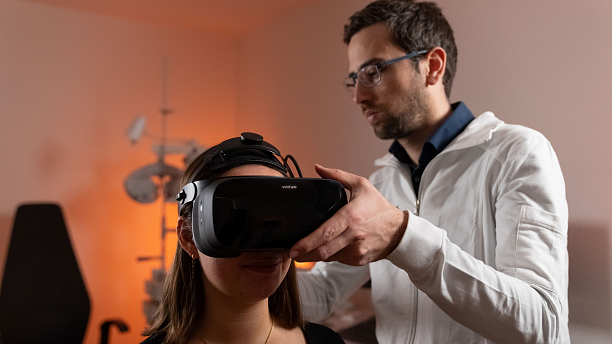

62159
machineMD
Revolutionizing eye examinations with speed and precision.
Switzerland
Market: Medicine, Artificial Intelligence
Stage of the project: Operating business
Date of last change: 27.06.2025
Switzerland
Market: Medicine, Artificial Intelligence
Stage of the project: Operating business
Date of last change: 27.06.2025
Idea
Nearly half the world suffers from neurological disorders — and half of them are misdiagnosed. MRIs are slow, costly, and out of reach for billions. At machineMD, we’ve built neos™ — an AI-powered, VR
Current Status
We launched commercially in Europe in October 2025 as a Class IIa EU-MDR-certified device, and in the US as a Class I FDA-listed device (with Class II clearance expected soon).
We’ve sold devices to leading clinical centers and top Key Opinion Leaders, securing early validation from the most influential experts in the field.
machineMD is the market leader in functional brain diagnostics through the eyes.
We’ve sold devices to leading clinical centers and top Key Opinion Leaders, securing early validation from the most influential experts in the field.
machineMD is the market leader in functional brain diagnostics through the eyes.
Market
Operating within the digital ophthalmic equipment sector, we cater primarily to ophthalmologists, optometrists, and neurologists. Focused initially on the US and Europe, our reach extends to approximately 120,000 potential customers, representing a market size of $1.1B based on our pricing model. The market holds potential for substantial growth through strategic targeting of opticians and general practitioners, incorporating additional reimbursable clinical tests, and expanding geographically, positioning us in a dynamic and expansive market space.
Problem or Opportunity
Billions of people suffer from neurological conditions, yet diagnosis remains slow, expensive, and inaccessible. Misdiagnosis rates are alarmingly high — nearly 50% — often causing irreversible harm. Traditional diagnostics like MRI are not suitable for continuous monitoring and are out of reach for much of the world.
We solve this by enabling continuous, non-invasive monitoring of brain health through the eyes — fast, affordable, and accessible anywhere.
We solve this by enabling continuous, non-invasive monitoring of brain health through the eyes — fast, affordable, and accessible anywhere.
Solution (product or service)
We’ve developed clinically certified algorithms that turn any eye-tracking-enabled VR or smart glasses into powerful neurodiagnostic tools. Our platform performs fast, objective, and affordable assessments by analyzing eye and pupil movements — enabling continuous monitoring of brain function.
neos™ is our flagship solution: a VR-based neuro-ophthalmoscope delivering accurate diagnostics in just 3 minutes, without the need for proprietary hardware.
neos™ is our flagship solution: a VR-based neuro-ophthalmoscope delivering accurate diagnostics in just 3 minutes, without the need for proprietary hardware.
Competitors
In today's standard of care the main competition is the manual examination of eye and pupil movements. There is not other company offering a comprehensive and fully automized assessment of the brain based on eye and pupil movements. However, there are a few competitors offering VR-based solutions that measure some of the tests needed for assessing the brain based on eye and pupil movements such as https://olleyes.com/
Advantages or differentiators
MachineMD's neos™ revolutionizes neuro-ophthalmic diagnostics by providing ophthalmologists and optometrists for the first time with an automated solution that performs comprehensive neuro-ophthalmic examinations on par with specialists. Its state-of-the-art technology combines high-frequency infrared eye tracking with an intuitive head-mounted display, tailored for use in diverse clinical settings. neos™ specifically targets quantifiable neuro-ophthalmologic biomarkers, offering diagnostics that are both precise and focused, surpassing the capabilities of general visual test devices. Designed by neuro-ophthalmology experts, neos™ is adept at identifying crucial functional optic biomarkers, enabling swift and accurate evaluations. With advanced VR, AI, and cloud-based integration, neos™ ensures real-time, efficient assessments, empowering general eye care professionals to deliver specialist-level examinations. This innovation positions neos™ as an essential tool for enhancing the quality of eye care.
Finance
machineMD plans a turnover of 60M in 5 years with approx. 6000 customers
Business model
We operate a hybrid model combining an initial device sale (to cover cost of goods) with a pay-per-exam software license, creating recurring revenue.
Today, we bundle our software with commercially available VR hardware — but we are transitioning to a pure software play, enabling deployment on existing and future VR/XR platforms for maximum scalability.
Today, we bundle our software with commercially available VR hardware — but we are transitioning to a pure software play, enabling deployment on existing and future VR/XR platforms for maximum scalability.
Money will be spent on
27% Marketing and Sales
39% Product development and clinical studies
7% Quality and Regulatory
11% COGS
2% IP
14% Other
39% Product development and clinical studies
7% Quality and Regulatory
11% COGS
2% IP
14% Other
Offer for investor
Preferred shares
Team or Management
Risks
Market: Slow adoption by clinicians
Product: Longer duration for developing a full diagnostic clinical decision support system
Product: Longer duration for developing a full diagnostic clinical decision support system
Incubation/Acceleration programs accomplishment
We have accomplished a number of programs in the US and in Europe.
Won the competition and other awards
- Winner of Innovation World Cup 2023
- Finalist of The Eddis Global
- Day One - Switzerland’s leading digital health and medtech accelerator
- Finalist of The Eddis Global
- Day One - Switzerland’s leading digital health and medtech accelerator
Invention/Patent
PCT/EP2022/069622
PCT/EP2022/069623
EP23211966
EP23199219
EP23194392
EP24173935
PCT/EP2022/069623
EP23211966
EP23199219
EP23194392
EP24173935
Photos

Presentation
Sign in/Sign up